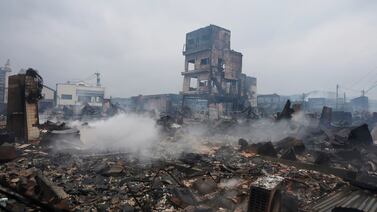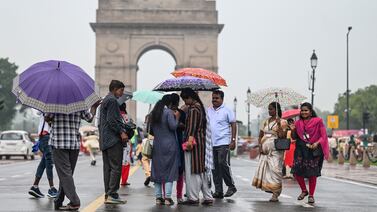Torrential rains across several north Indian states, including the capital Delhi, wreaked havoc on Friday, causing waterlogging and traffic jams, prompting several cities to shut schools and offices.
The capital and neighbouring cities have endured incessant monsoon rains since Thursday as the weather office predicts continued wet weather over the weekend.
A “yellow warning” — a colour coding system that indicates severely bad weather and rain measuring more than 64 millimetres — was issued by the meteorological office as the annual monsoon begins to fade from the region.

The critical monsoon season begins in June in the Indian sub-continent and starts withdrawing in September after more than three months of winds and rain that sustains India’s agricultural sector.
Authorities said several motorways and other roads were flooded and trees uprooted in parts of Delhi and adjoining cities, causing traffic woes for tens of thousands of commuters.
Water pumps were used to drain water from flooded areas.
“It took me three hours to reach home from work, more than double the usual time,” Neha Sharma, a Delhi resident, told The National.
In Gurgaon — a satellite city outside Delhi that is home to several Fortune 500 companies including Google and Microsoft — schools were closed and people advised to work from home because of heavy rains that have lashed parts of the city since Thursday.
Several motorways in the city had kilometres of traffic jams after 55mm of rain on Thursday triggered waterlogging and disrupted commuter movement.
"All corporate offices and private institutions in the district are advised to guide their employees to work from home so that traffic congestion can be avoided," the Gurugram disaster management authority said in its advisory.

The city, also known as India’s “millennium city”, suffers from chronic underdeveloped infrastructure, a flawed drainage network and often suffers flooding during the monsoon season.
Visuals posted by agitated commuters on social media showed people wading through knee-deep water and vehicles stuck in muddy waters.
Authorities in Noida near Delhi also closed schools while some offices also asked employees to work from home.
Twelve dead after rain and lightning
Incessant rains also wreaked havoc in several cities across the country’s most-populous Uttar Pradesh state where 12 people have been killed in rain-related incidents, including lightning, since Wednesday.
Authorities in Aligarh city closed schools until Saturday after rains brought life to a standstill.
Last week, nearly 25 people died in rain-related incidents in the state including 10 workers after a wall of a military command centre fell in the state capital Lucknow.
Heavy rains and landslides were also reported from Uttarakhand state.

Several Indian states and cities have borne the brunt of heavy rains in recent months, including in southern Bangalore city, where days of rains led to flooding.
India has recorded a 7 per cent excess in rainfall this monsoon season, but several regions suffered a deficit.
South Indian states experienced 26 per cent excess rain but states in the east and north-east suffered a 17 per cent deficit. States such as in Punjab, Bihar, Jharkhand and Uttar Pradesh recorded 20 per cent to 33 per cent less rain.
Delhi recorded a 36 per cent deficit in rain during the monsoon, India's weather office reported.









